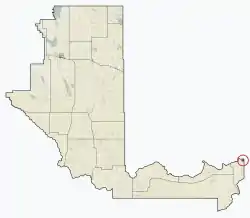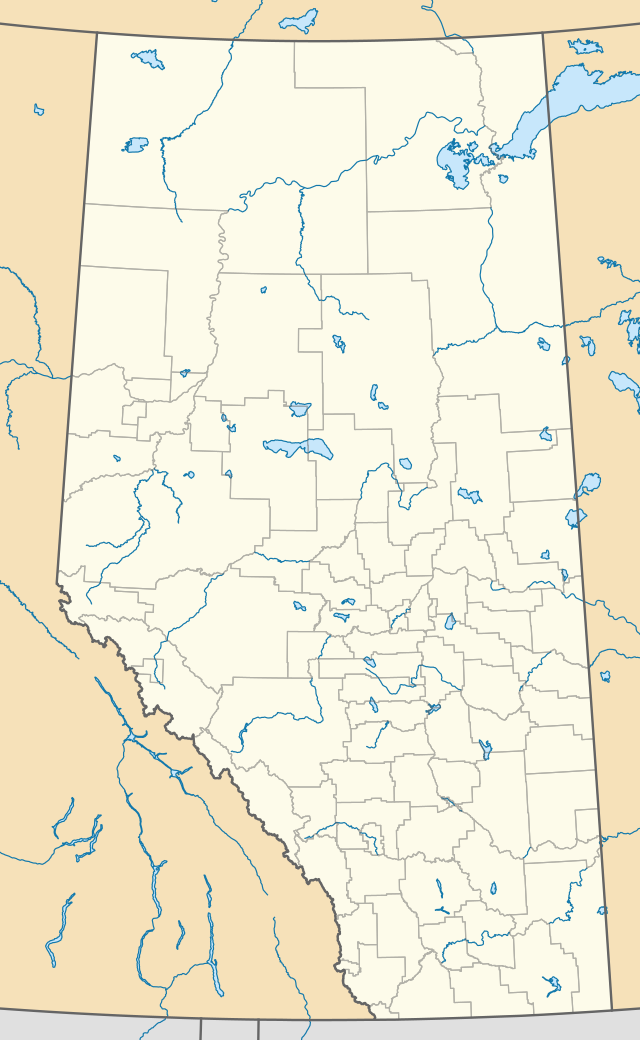Empress, Alberta
Empress is a village located along the Alberta/Saskatchewan border; in southern Alberta 121 kilometres (75 mi) north of Medicine Hat. The town was named, in 1913, for Queen Victoria, who was also Empress of India.[5][6] In the past it was known as the "Hub of the West", connecting major cities together by the Canadian Pacific Railway.
Empress | |
|---|---|
| Village of Empress | |
 Location in Special Area No. 2 | |
 Empress Location of Empress in Alberta | |
| Coordinates: 50°57′17.4″N 110°00′31.4″W | |
| Country | Canada |
| Province | Alberta |
| Planning region | Red Deer |
| Special Area | No. 2 |
| Incorporated[1] | |
| • Village | February 5, 1914 |
| Government | |
| • Mayor | Sandra Crooker[3] |
| • Governing body | Empress Village Council |
| Area (2016)[4] | |
| • Land | 1.58 km2 (0.61 sq mi) |
| Elevation | 615 m (2,018 ft) |
| Population (2016)[4] | |
| • Total | 135 |
| • Density | 85.3/km2 (221/sq mi) |
| Time zone | UTC−7 (MST) |
| • Summer (DST) | UTC−6 (MDT) |
| Postal code span | T0J 1E0 |
| Highways | Highway 562 |
| Waterways | Red Deer River South Saskatchewan River |
| Website | villageofempress.com |
It is located at the confluence of Red Deer River and South Saskatchewan River, at an elevation of 650 metres (2,130 ft). It is connected to Buffalo Trail by Highway 899 and Highway 562.
Demographics
The population of the Village of Empress according to its 2017 municipal census is 160.[7]
In the 2016 Census of Population conducted by Statistics Canada, the Village of Empress recorded a population of 135 living in 58 of its 71 total private dwellings, a -28.2% change from its 2011 population of 188. With a land area of 1.58 km2 (0.61 sq mi), it had a population density of 85.4/km2 (221.3/sq mi) in 2016.[4]
In the 2011 Census, the Village of Empress had a population of 188 living in 69 of its 73 total dwellings, a 38.2% change from its 2006 population of 136. With a land area of 1.75 km2 (0.68 sq mi), it had a population density of 107.4/km2 (278.2/sq mi) in 2011.[8]
Climate
Located in the steppe region known as Palliser's Triangle, Empress experiences a semi-arid climate (Köppen climate classification BSk). Winters are long, cold and dry, while summers are short, but with average daytime highs that are warm to hot, though nighttime lows are cool. Spring and autumn are quite short, essentially transition periods between winter and summer. Wide diurnal temperature ranges are regular, due to the aridity and moderately high elevation. Low humidity is prevalent throughout the year. Annual precipitation is very low, with an average of 312mm, and is heavily concentrated in the warmer months. On average, the coldest month is January, with a mean temperature of −12 °C (10 °F), while the warmest is July, with a mean temperature of 20 °C (68 °F). The driest month is February, with an average of 9 millimetres (0.35 in) of precipitation, while the wettest is June, with an average of 69 millimetres (2.7 in).[9]
| Climate data for Empress, Alberta | |||||||||||||
|---|---|---|---|---|---|---|---|---|---|---|---|---|---|
| Month | Jan | Feb | Mar | Apr | May | Jun | Jul | Aug | Sep | Oct | Nov | Dec | Year |
| Record high °C (°F) | 12.0 (53.6) |
17.0 (62.6) |
28.0 (82.4) |
32.0 (89.6) |
36.0 (96.8) |
41.1 (106.0) |
42.2 (108.0) |
41.7 (107.1) |
38.3 (100.9) |
31.7 (89.1) |
23.0 (73.4) |
15.0 (59.0) |
42.2 (108.0) |
| Average high °C (°F) | −6.5 (20.3) |
−2.6 (27.3) |
4.8 (40.6) |
13.9 (57.0) |
19.7 (67.5) |
23.8 (74.8) |
27.4 (81.3) |
27.0 (80.6) |
20.4 (68.7) |
12.9 (55.2) |
1.7 (35.1) |
−4.7 (23.5) |
11.5 (52.7) |
| Daily mean °C (°F) | −12.0 (10.4) |
−8.3 (17.1) |
−1.2 (29.8) |
6.6 (43.9) |
12.5 (54.5) |
16.9 (62.4) |
19.8 (67.6) |
19.1 (66.4) |
12.8 (55.0) |
5.8 (42.4) |
−3.8 (25.2) |
−10.1 (13.8) |
4.8 (40.6) |
| Average low °C (°F) | −17.5 (0.5) |
−14.1 (6.6) |
−7.2 (19.0) |
−0.7 (30.7) |
5.2 (41.4) |
9.9 (49.8) |
12.1 (53.8) |
11.1 (52.0) |
5.2 (41.4) |
−1.2 (29.8) |
−9.3 (15.3) |
−15.4 (4.3) |
−1.8 (28.8) |
| Record low °C (°F) | −47.8 (−54.0) |
−45.6 (−50.1) |
−40.0 (−40.0) |
−28.9 (−20.0) |
−14.4 (6.1) |
−4.4 (24.1) |
0.0 (32.0) |
0.0 (32.0) |
−10.0 (14.0) |
−26.0 (−14.8) |
−36.5 (−33.7) |
−45.0 (−49.0) |
−47.8 (−54.0) |
| Average precipitation mm (inches) | 14.2 (0.56) |
8.6 (0.34) |
12.7 (0.50) |
18.7 (0.74) |
38.8 (1.53) |
68.9 (2.71) |
50.3 (1.98) |
33.9 (1.33) |
28.5 (1.12) |
11.5 (0.45) |
10.8 (0.43) |
14.8 (0.58) |
311.6 (12.27) |
| Average rainfall mm (inches) | 0.2 (0.01) |
0.3 (0.01) |
2.1 (0.08) |
13.8 (0.54) |
38.2 (1.50) |
68.9 (2.71) |
50.3 (1.98) |
33.9 (1.33) |
28.1 (1.11) |
7.5 (0.30) |
1.0 (0.04) |
0.4 (0.02) |
244.5 (9.63) |
| Average snowfall cm (inches) | 13.9 (5.5) |
8.3 (3.3) |
10.6 (4.2) |
4.9 (1.9) |
0.7 (0.3) |
0.0 (0.0) |
0.0 (0.0) |
0.0 (0.0) |
0.5 (0.2) |
4.1 (1.6) |
9.8 (3.9) |
14.8 (5.8) |
67.1 (26.4) |
| Source: Environment Canada[10] | |||||||||||||
See also
References
- "Location and History Profile: Village of Empress" (PDF). Alberta Municipal Affairs. October 21, 2016. p. 281. Retrieved October 23, 2016.
- "Municipal Officials Search". Alberta Municipal Affairs. September 22, 2017. Retrieved September 25, 2017.
- Village of Empress Website, Meet Your Council
- "Population and dwelling counts, for Canada, provinces and territories, and census subdivisions (municipalities), 2016 and 2011 censuses – 100% data (Alberta)". Statistics Canada. February 8, 2017. Retrieved February 8, 2017.
- The Canadian Encyclopedia: Victoria Archived September 10, 2009, at the Wayback Machine
- Place-names of Alberta. Ottawa: Geographic Board of Canada. 1928. p. 48.
- "2017 Municipal Census". Village of Empress. Archived from the original on January 14, 2018. Retrieved January 13, 2018.
- "Population and dwelling counts, for Canada, provinces and territories, and census subdivisions (municipalities), 2011 and 2006 censuses (Alberta)". Statistics Canada. February 8, 2012. Retrieved February 8, 2012.
- "Environment Canada - Canadian Climate Normals 1971-2000". Retrieved August 19, 2010.
- "Empress, Alberta". Canadian Climate Normals 1981–2010 (in English and French). Environment Canada. Retrieved March 11, 2014.